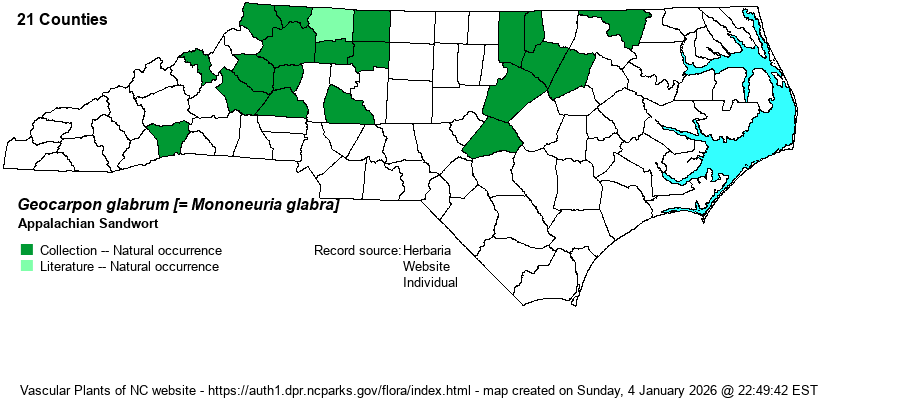| Author | (Michaux) E.E. Schilling | |
| Distribution | Present over much of the Piedmont, more so in the northern half; sparingly in the Mountains, at lower elevations. Occurs primarily in two regions -- the Rolesville Pluton area in the northeastern Piedmont, and the granitic dome region mainly in the northwestern Piedmont. In the Mountains, it is limited mostly to lower elevations, seldom over 3000 feet.
This is an Eastern species essentially of the mountains and Piedmont. It ranges from ME southward into AL, with a disjunct region northward into eastern TN and southeastern KY. | |
| Abundance | Locally fairly common to common where granite flatrocks and domes are present, but quite uncommon elsewhere in the Piedmont, and seemingly absent in the southern part of the province. Also absent in much of the Mountain province. | |
| Habitat | This is a granitic flatrock and dome species, never seen away from rocks. Most populations grow in shallow soil around the edges of the rock exposures. It does not grow in rocky summits, cliffs, and other jagged rocks. | |
| Phenology | Blooms in April and May, and fruits soon after flowering. | |
| Identification | This is a very slender and delicate plant, with a single stem growing to about 6 inches tall. Though it has a small basal rosette of leaves, these are gone by flowering, and thus the main leaves are along the stem -- opposite and very short and slender (linear), about 1/2-inch long. There are several ascending branches, each with a single fairly large white flower, consisting of 5 white petals and a flower spread of about 1/2-inch across. Several other species are quite similar. G. groenlandicum is more mat-forming, only about 2-3 inches tall, has fewer flowers (mostly just 3-7 as opposed to 9-15 in G. glabrum), but it has larger petals than the other, with a spread flower about 2/3-inch across. That species grows mostly at higher elevations in the mountains, though both could occur together. G. uniflorum, growing in NC only in the southern half of the Piedmont and southern mountains, has few flowers per stem, and the leaves are barely 1/10-inch long. Though G. glabrum does not form mats, large patches grow around margins of the flatrocks and can be quite spectacular in spring when in full bloom. | |
| Taxonomic Comments | This species was formerly just a variety of Arenaria groenlandica in RAB (1968) and some other older references. It later was split into its own species, as A. glabra. Most other similar species have been moved over to Minuartia and now mainly to Mononeuria. And, in 2022, Schilling moved most of the genus now to Geocarpon. Weakley (2022) has followed this latest move -- certainly not the last!
| |
| Other Common Name(s) | Appalachian Stitchwort, Appalachian False Stitchwort | |
| State Rank | S3 | |
| Global Rank | G4 | |
| State Status | | |
| US Status | | |
| USACE-agcp | | |
| USACE-emp | | |

